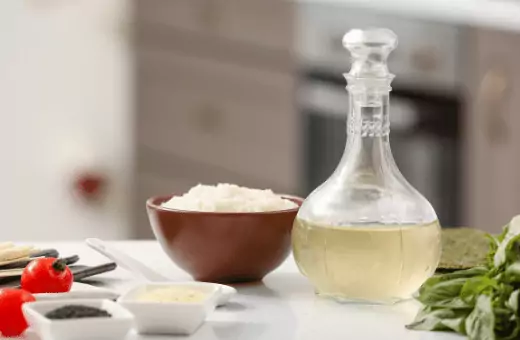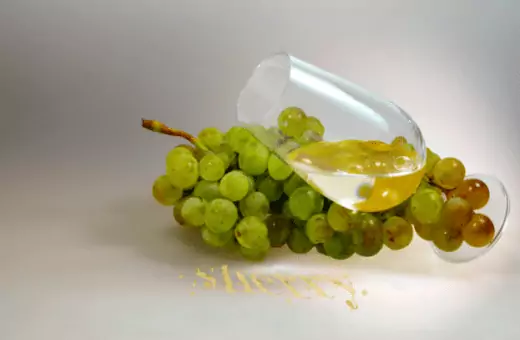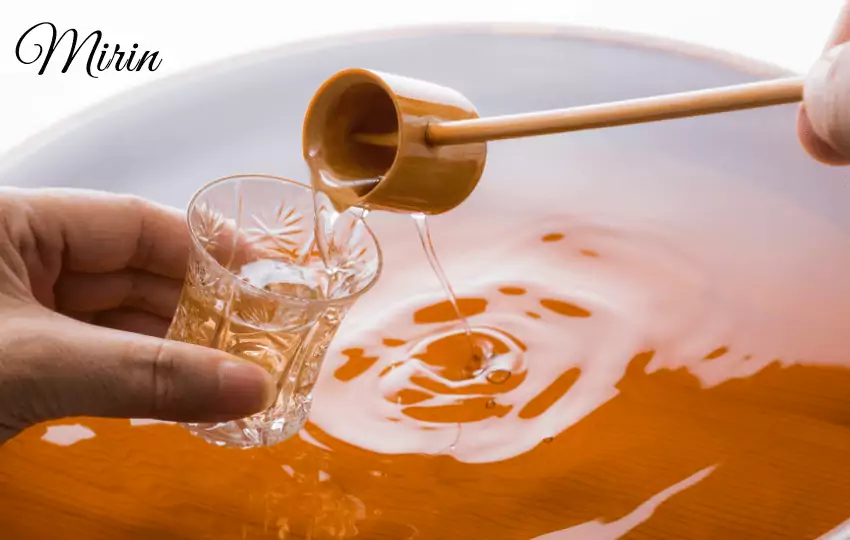Do you want some traditional Japanese cuisine taste but Want to avoid Mirin! Then you are today in the right place to get some non-alcoholic mirin substitute to maintain the taste you desire.
I already tried some, and honestly, it did not get the exact mirin function. Still, Yes, the substitute keeps the fragrance and savouriness the same.
What is Mirin:
Mirin is a rice wine used as a condiment in Japanese cuisine. It’s made from glutinous rice, kome-koji (grain used to make sake), and sugar.
The alcohol present in Mirin evaporates when heated; hence it’s traditionally added at the end or not used when preparing the dish.
The one problem with traditional Mirin is its alcoholic content, making it illegal for children to purchase in Japan.
Since many recipes call for Mirin, this has led to some exciting substitutes being put forward by concerned parents who still want their children to enjoy authentic Japanese cooking.
Here are some suggestions you can try out yourself if you don’t fancy grabbing an entirely new bottle of wine just for the sake of cooking:
10 Non-alcoholic substitutes for Mirin
When looking for a non-alcoholic substitute for Mirin, you have a few different options. For example, you could use rice vinegar, sugar, and so on.
1. RICE VINEGAR
Rice vinegar is an excellent substitute for Mirin in many recipes. It has a slightly sweet-sour and acidic taste, adding depth of flavor to dishes.

Rice vinegar is also less sweet than Mirin, so it can be a good choice if you want a more subtle sweetness in your dish.
To use rice vinegar instead of Mirin, simply replace the same amount of Mirin with rice vinegar in your recipe.
If a recipe calls for 1 tablespoon of Mirin, use 1 tablespoon of rice vinegar instead. Be sure to taste your dish as you cook it, and adjust the amount of rice vinegar as needed to get the desired flavor.
Some dishes that can be made with rice vinegar instead of Mirin includes:
· Sushi
· Teriyaki sauce
· Salad dressings
· Pickled vegetables
· Asian-inspired stir-fries
There are many different types of rice vinegar available on the market, so be sure to pick one that will work nicely with the flavors of your dish.
For example, suppose you’re making a sushi roll with a teriyaki sauce. In that case, you’ll want to use rice vinegar with a slightly sweet flavor.
If you’re making a pickled vegetable salad, you might want to use rice vinegar with a more sour taste. Experiment with different types of rice vinegar until you find one that you like best.
2. HONEY
You can use a few substitutes for Mirin in your cooking, but honey is one of the best.
Honey has a sweetness that mirrors that of Mirin, and it also has a slight tanginess that will add depth to your dish.
Here is a few advice on how to use honey as a substitute for Mirin in your cooking:
1. Add honey to sauces and glazes. If you’re making a teriyaki sauce or glaze, for example, add honey in place of some of the soy sauce. The honey will add sweetness and complexity to the dish.
2. Use it as a marinade. If you’re marinating meat or fish, add honey to the marinade in place of Mirin. The honey will add a bit of sweetness, and the natural sugars in your food will caramelize as you cook it.
3. Use it in stir fry. Add honey to your stir fry recipes instead of Mirin or sugar for a more complex flavor profile that creates a beautiful glaze on your dish when cooked.
4. Substitute it for white sugar in dessert recipes that call for sweetening liquids like fruit puree, jams, syrups, etc. This is especially good with apples since they have an earthy depth that’s perfect with honey’s slight tanginess.
Honey can even be used as a 1:1 replacement for corn syrup in candy making, so if you’re making any traditional candy recipes that call for corn syrup, try substituting it for honey instead.
5. Use it in salad dressings instead of sugar or vinegar. Add 2-3 tablespoons of honey to your vinaigrette recipe and whisk until the honey dissolves completely.
Honey pairs really well with balsamic and red wine vinegar, so try either or create your own new combination!
3. COMBINE VINEGAR & SUGAR
Use 1 tablespoon of white vinegar and 1 tablespoon of sugar for every 1 tablespoon of Mirin.
The combination will give your stir-fry a slightly sharper taste than Mirin.
If you’re looking for a more significant flavor difference, consider using 2 tablespoons of vinegar and 2 tablespoons of sugar.
You can also alter the ratio depending on your own preferences. Just be sure to mix the ingredients well before adding them to your dish.
4. DRY SHERRY
Use dry sherry as a substitution for Mirin. Just ensure that you add it to the dish early on so that the flavors have time to meld together.

For dry sherry, use 1/3 cup of sherry for every 1/4 cup of Mirin called for in the recipe. White wine can also be substituted if you don’t have either on hand.
You can also use rice vinegar or apple cider vinegar as a substitute in a pinch. However, these substitutions will not give the same results as Mirin, so it’s best to stick to one of the substitutes mentioned above if possible.
When using Mirin in cooking, it’s important to remember that its flavor is quite strong. A bit goes a long way, so start with one or two teaspoons and add more as needed.
Mirin is also a high-sugar ingredient, so it’s best to use it sparingly if you’re trying to watch your sugar intake.
You can easily replace Mirin with another cooking liquid in your recipes with a bit of investigation and still achieve delicious results.
So bring innovation in the kitchen and have some fun with new flavor combinations!
5. HOMEMADE MIRIN SUBSTITUTE- SAKE & SUGAR
Simply mix equal parts of sake and sugar, and heat until the sugar has dissolved.
This mixture will keep in the refrigerator for up to two weeks and can be used in place of Mirin in any recipe.
However, it should be noted that this homemade substitute does not have the same depth of flavor as Mirin, so you might want to use twice as much to achieve similar results.
6. Use a mixture of equal parts apple cider vinegar and honey.
Apple cider vinegar and honey are both natural sweeteners that can be used in place of Mirin in cooking.
Honey is sweeter than sugar; you’ll require less of it to get the same level of sweetness. Apple cider vinegar has a sour flavor that can add balance to sweet dishes.
It is also a good source of probiotics, promoting gut health. When substituting apple cider vinegar for Mirin, start with a small amount and add more as needed.
Note that apple cider vinegar and honey flavors may vary depending on the type of honey and apple cider vinegar used.
Here are a few recipes that utilize apple cider vinegar and honey as substitutes for Mirin:
· Sautéed Chicken with Apple Cider Vinegar and Honey Sauce
· Sautéed Cod with Apple Cider Vinegar and Honey Sauce
· Chinese Five-Spice Shrimp Stir Fry
· Miso Grilled Salmon with Honey and Apple Cider Vinegar
· Honey-Roasted Butternut Squash with Apple Cider Vinegar
· Apple Cider Vinegar and Honey Salad Dressing
When using apple cider vinegar and honey in place of Mirin, keep the following tips in mind:
Begin with a slight amount and add more as required. The flavors of apple cider vinegar and honey may vary depending on the type of honey and apple cider vinegar was used.
-Be careful not to over-sweeten dishes with honey. To achieve the same level of sweetness, use less honey compared to sugar.
-Apple cider vinegar has a sour flavor that can be used to add balance to sweet dishes.
7. OTHER MIRIN SUBSTITUTES (NON-ALCOHOLIC)
- Blend 1 tablespoon of sugar with 1 tablespoon of rice vinegar and heat in a small pan until the sugar has melted. This will provide you a matching flavor to Mirin.
- Soak one tablespoon of kome-koji in water for 30 minutes, then add it to 1 cup of rice vinegar.
Heat until the kome-koji has dissolved, then strain out any solids. Add this mixture to a pan with 1 cup of sugar and heat until it thickens and coats the back of a spoon. This will also give you a mirin substitute closer to the real thing.
- Combine 1 cup of white sugar, 2 tablespoons of corn syrup, and 1 tablespoon of sake in a pan. Heat them together until you have syrup, and the alcohol has evaporated, but be careful not to let it burn.
- Use apple juice instead of Mirin for lighter dishes like tempura or takikomi Gohan (rice with vegetables).
You’ll need 2 cups of fresh apple juice, 3 tbsp of sugar, and 2 tsp cornstarch. Simply mix the ingredients in a pan, then heat until thickened.
If you want to make this into a natural mirin substitute, adding 1/4 cup 33% vinegar will help give it that rice wine flavor without actually using any alcoholic beverages (yay!).
Wrap Up On- Mirin and Its Non Alcoholic Substitutes
So, there you have it – a few different non-alcoholic substitutes for Mirin.
Just remember that each of these substitutes has a slightly different flavor profile, so be sure to experiment until you find the one that works best for your dish. Happy cooking!
FAQs Related to Non-alcoholic Alternative To Mirin
Q1.What is an excellent non-alcoholic substitute for Mirin?
First of all, Mirin is a sweetened sake that you can find in any Japanese grocery store. Mirin has a distinctive sweet flavor that adds great umami to dishes.
If you don’t have Mirin on hand, try using 1/2 teaspoon white sugar mixed with 1/2 tablespoon rice vinegar = 1 tablespoon mirin.
In Asian markets, there are also various kinds of mirins on the market. [In Japan], there are Kanto region-style mirin and Kansai region-style mirin (made by different towns), so choose according to your personal preference.
Q2. What are some common uses for Mirin?
There are many different ways to use Mirin in cooking. It can be used as a marinade for meat or fish, added to sauces or dressings, or used as a finishing touch on cooked dishes.
Mirin can also be used in baking, either alone or in combination with other ingredients like soy sauce or sugar.
Q3. Is Mirin the same as rice wine?
Mirin is a variety of rice wines, but it has a lower alcohol content and higher sugar content than most other types of rice wine.
This makes Mirin a better choice for cooking. It will add sweetness and flavor to dishes without making them too alcoholic.

